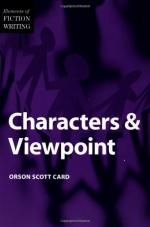
|
| Name: _________________________ | Period: ___________________ |
This test consists of 15 multiple choice questions and 5 short answer questions.
Multiple Choice Questions
1. According to the quote that ends Chapter 3, where does the author believe a writer can find wonderful stories?
(a) No landscapes on earth.
(b) Any landscape on earth.
(c) Most landscapes on earth.
(d) Very few landscapes on earth.
2. Which one of the following triggers a negative reaction from readers?
(a) A character who confuses others.
(b) A character who is controlled by others.
(c) A character who is confusing.
(d) A character who wants power or control.
3. What will many experienced authors claim about their characters?
(a) They were completely invented for the story.
(b) They were taken from other literary works.
(c) They were inspired by history.
(d) They were taken from life.
4. What does the author think about characters from unrelated ideas?
(a) It would be interesting, but it is not possible to put them together.
(b) It is both possible and interesting to put them together.
(c) It is possible to put them together, but not interesting.
(d) It is neither possible nor interesting to put them together.
5. Why does a character in a novel pursue a transformation in his/her life?
(a) His/her role has become insignificant.
(b) His/her role has become complicated.
(c) His/her role has become unpredictable.
(d) His/her role has become unbearable.
6. In order to avoid being boring, what does a character have to be?
(a) Passive and mysterious.
(b) Familiar and idiosyncratic.
(c) Aggressive and mysterious.
(d) Unfamiliar and idiosyncratic.
7. How often are sources of inspiration altered?
(a) Hardly at all.
(b) Never.
(c) Sometimes.
(d) Very often.
8. What will help a writer to maintain consistency?
(a) Not having more than three central characters.
(b) Keeping a list of character traits and facts.
(c) Keeping a list of character names.
(d) Not having more than four supporting characters.
9. What two things should a writer be open to translating into their characters and stories?
(a) Impossibility and insight.
(b) Impossibility and the unknown.
(c) Possibility and the unknown.
(d) Possibility and insight.
10. What do the most engaging characters reveal about themselves?
(a) Unknown fears.
(b) Unknown flaws.
(c) A heroic side.
(d) Fearlessness.
11. Which one of the following is not a powerful resource for finding characters listed by the author?
(a) The writer's self.
(b) The writer's feelings.
(c) The writer's unrelated memories.
(d) The writer's previous works.
12. In an event-driven narrative, what is the goal of the characters?
(a) To prevent an intolerable situation.
(b) To avoid an intolerable situation.
(c) To hide an intolerable situation.
(d) To change an intolerable situation.
13. How does the author describe what it means to "raise the stakes"?
(a) Increasing what a character has to lose, but not to gain.
(b) Increasing what a character has gained.
(c) Increasing what a character has lost.
(d) Increasing what a character has to lose or gain.
14. What does the author hope to give writers who read the book?
(a) A popular method.
(b) A specific set of instructions.
(c) A set of tools.
(d) A secret formula.
15. How many of the basic elements of a narrative does milieu incorporate?
(a) None of them.
(b) All of them.
(c) Three of them.
(d) One of them.
Short Answer Questions
1. According to the author, where do characters come from?
2. What should the writer's own experiences have in order to be used as fictional inspiration?
3. What does the contract between an author and a reader state?
4. What kinds of situations can make a character more interesting?
5. What do the readers and creators of a contemporary narrative believe about in-depth characterization?
|
This section contains 664 words (approx. 3 pages at 300 words per page) |

|




